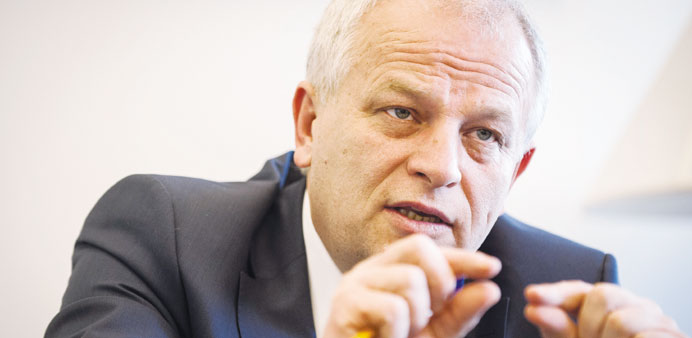Bloomberg /Kiev
Ukraine’s banks need at least 50bn hryvnia ($4.2bn) to 60bn hryvnia in fresh capital, central bank Governor Stepan Kubiv said, giving a more downbeat view than the country’s biggest foreign lender.
The monetary authority seeks to maintain the solvency of the banking system after Russia’s annexation of Crimea and a war against pro-Russian separatists in the east drove off foreign investors and shut bank branches in areas wracked by violence.
The economy may shrink 7% this year, the European Bank for Reconstruction & Development said this week. The hryvnia extended the world’s biggest slump yesterday.
Ukraine’s banking system will probably see a year or two of losses as local and foreign-owned lenders “freeze operations” until they get more clarity on the country’s future, analysts at Raiffeisen Bank International AG, including Gunter Deuber in Vienna, wrote yesterday. Raiffeisen, the biggest foreign bank in the country, sees recapitalization needs between $3bn and $5bn in the coming 18 months as the hryvnia’s devaluation curbs banks’ capital adequacy.
Ukraine is going “through a period of bank insolvencies and consolidation,” Kubiv said yesterday in an interview at the EBRD’s annual meeting in Warsaw. “Our preliminary estimation exceeds Raiffeisen’s by a bit.”
Liquidity operations by the central bank have pushed down the KIEVPrime overnight rate, which tracks borrowing costs among lenders, to 5.25% yesterday from as much as 30.6% in February, highlighting more access to short-term cash.
The hryvnia, which traded at 8.24 per dollar on December 31, weakened 1.1% to 11.96 against the US currency by 3:00 p.m. in Kiev. Its 31% retreat this year is the worst performance among more than 170 peers monitored by Bloomberg.
Stress tests being carried out on Ukrainian banks use scenarios of 25% and 50% devaluations in the hryvnia from about 8 to the dollar, Kubiv said.
The 15 biggest lenders will complete the tests by the end of July, while 20 more will follow suit by October, according to a government document submitted to the IMF last month.
There are “too many banks, many of them are not really viable” in Ukraine, EBRD President Suma Chakrabarti said in a May 12 interview in Kiev. “There’s probably going to be some consolidation of banks.”
Raiffeisen and UniCredit SpA, the second-biggest foreign bank in Ukraine, put their units in the country up for sale this year to free up funds to invest in more profitable countries.
Raiffeisen gave up the plan as the crisis worsened, and UniCredit’s General Manager Roberto Nicastro said this week the sale was now “on hold.”
OTP Bank Nyrt., Hungary’s largest bank, posted a 48% decline in first-quarter profit on losses in Russia and Ukraine and said its subsidiaries in those countries won’t make a profit this year.
Bad-debt provisions will rise further in Ukraine due to hryvnia weakness and economic contraction, Chief Financial Officer Laszlo Bencsik told reporters in Budapest today.
“A lot of banks may need recapitalization, driven by hryvnia devaluation and accelerated balance-sheet clean-up, and this could become an issue for some local private banks,” Raiffeisen’s Deuber said in the study. “The Ukrainian authorities should quickly come up with a mechanism to raise their firepower.”
Ukraine’s benchmark bonds rebounded this week on optimism Russia won’t deploy forces in the country’s east even as the government in Kiev pushed ahead with an offensive against separatists.
The yield on the dollar note due 2023 fell less than one basis point to 9.94% today, the lowest since April 22, after rising as high as 11.37% in February.
A $17bn aid program approved by the IMF last month has already helped stabilise the hryvnia and the banking system, Alina Slyusarchuk, a London-based economist at Morgan Stanley, wrote in an e-mailed report today.
Ukraine’s move to a flexible exchange rate in February was a “right step,” even as a “speculative component” in the market keeps the hryvnia weak, Kubiv said.

